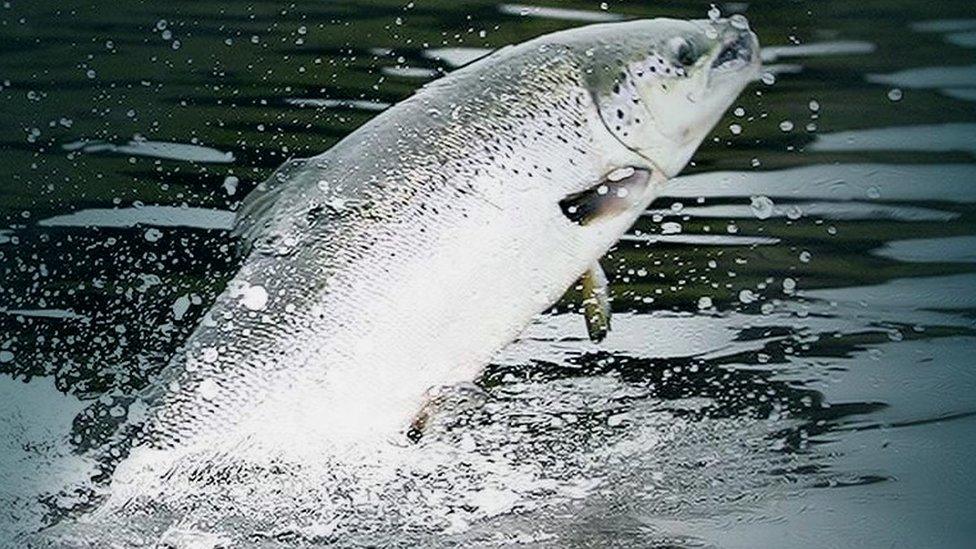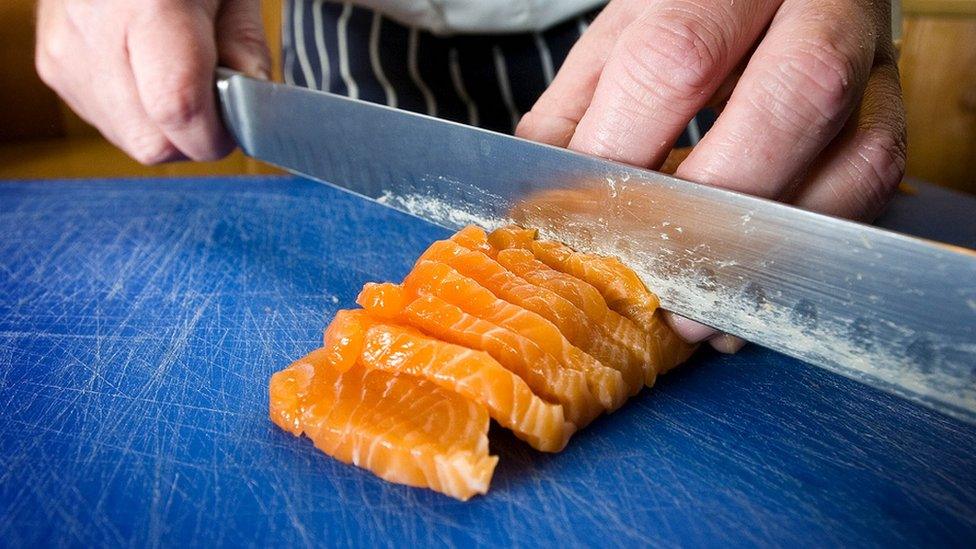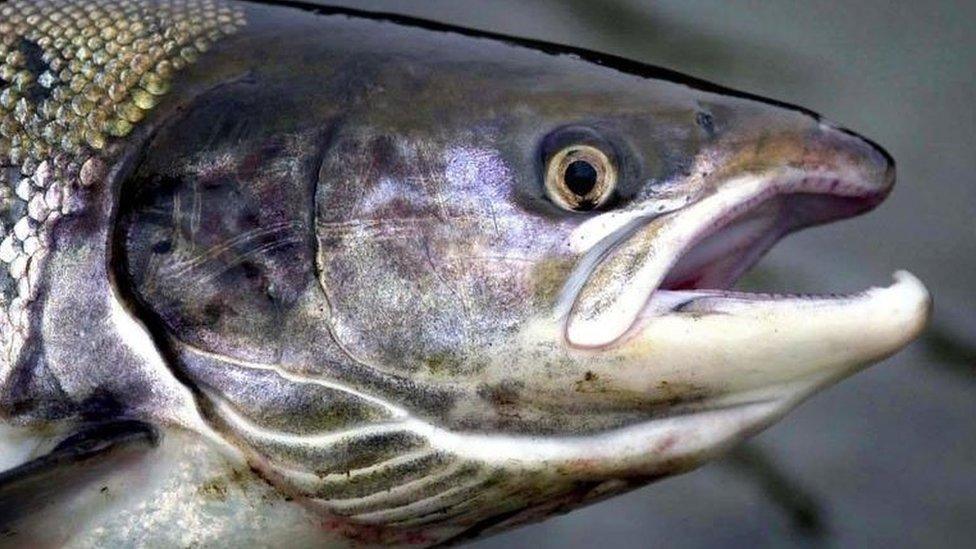How Scottish salmon conquered the world
- Published

In 2014, Scottish salmon beat confectionery to become the UK's most valuable food export
Past midnight on Monday in Mallaig: a boat docks with a cargo of live salmon.
They've been shipped from one of dozens of fish farms in the sea lochs of Scotland's north-west coast, where they swam earlier on Sunday in a large cage, machine fed for up to three years, growing as big as 8kg.
Mallaig is on a picturesque promontory looking over the sea to Skye. Its harbour used to heave with herring boats: its bracing fresh air mingled with the potent tang of smoking kippers.
The wild catch at Mallaig quayside is now langoustine, scallops and lobster. Many of the shellfish are bound for markets in Spain and France, trucked live and swiftly for premium prices.
The bigger fish business in the west Highlands is the farming of Atlantic salmon.
From the fishing boat they are vacuumed through a pipe into the ice house, slaughtered, packed and driven along the winding road through the Lochaber region to a processing plant at Fort William. They are gutted and despatched to markets around the world.
By Thursday, some of the bigger fish are being served in China's best restaurants. Beijing first allowed imports of Scottish salmon in 2011. Last year, more than 11,000 tonnes were exported to the Far East, with a value of £73m ($94m).
It is 25 years since Scottish salmon became the first non-French food to win the Label Rouge designation. Based on taste and appearance, that has been a valuable asset in France, the biggest European market for salmon, and an important calling card in other countries.

Firm, less fatty salmon is particularly popular for sushi and sashimi
Salmon is now by far the biggest food export from Scotland. In 2014, it beat confectionery to become the UK's biggest food export., external
Demand is led by the EU, which imported 35,000 tonnes of Scottish salmon last year, and the US, which imported nearly 26,000 tonnes.
While the UK has less than a tenth of global production, Scotland offers a premium product, at about 10% above the world price. Scottish salmon is typically fed better quality feed, and farming can be less intensive - fewer fish in a cage mean they swim further, and develop more muscle.
Loch Duart set out in 1999 to carve a niche within that Scottish niche. Farming in the sea lochs of Sutherland and the Outer Hebrides, it charges a premium of 20-25% over other salmon producers, selling to wholesalers whose high-end client chefs require that extra assurance of quality and reliability.
"We've got to have an authentic message, a clear set of farming principles that the customer can buy into, that can be verified. We were the first to have RSPCA welfare standards," says sales director Andy Bing.
Scott Landsburgh, chief executive of industry body the Scottish Salmon Producers Organisation (SSPO), points out that fresh fish is hard to differentiate, except on its look. "The good quality flesh of the fish [is] particularly firm and less fatty. And that works in the sushi and sashimi market in particular," he says.

Unilever began Scottish salmon farming in 1965 and produced its first fish from Lochailort in 1971
The journey for Scottish salmon began nearly 50 years ago.
Unilever was the pioneer, spotting the potential for farmed salmon, which at that time was only caught wild and eaten as an expensive luxury.
The food conglomerate's Marine Harvest division first produced farmed salmon in 1971 at Lochailort - the shoreline between Mallaig and Fort William - and is today the world's largest salmon farmer. Now an independent firm, Marine Harvest is based in Bergen, Norway, the country that dominates the industry. (Norwegian annual production has topped 1.1m tonnes, while the UK produces less than 160,000 tonnes.)
Scotland's most valuable export - Scotch whisky - has helped to fuel the popularity of the country's salmon, by projecting a reputation for quality and provenance.
"The inroads the whisky industry made have helped with Scotland the Brand, but salmon doesn't sell itself," observes Steve Bracken, spokesman for Marine Harvest and an industry veteran.
He points out that producers have worked hard alongside the SSPO and the Scottish Food and Drink trade body to promote the fish. The public sector's contribution has been significant too, through Scottish Development International, the government agency that promotes exports.

Sea lice can weaken the health of salmon and their growth
However, recently Scottish salmon's growth has been scaled back with production hit by sea lice. When the parasites take hold of a farm, fish are harvested before their health deteriorates.
That helps explain why total world tonnage was down by 7% last year - by 5% in Scotland and Norway, and 16% in Chile. The South American country is the second biggest producer of Atlantic salmon, but has been blighted by the rapid spread of fish disease.
The industry has yet to get on top of sea lice. Feeder fish can be used as a predator for the parasites, but they haven't solved the problem yet. Another answer could be cages strong enough to be anchored far out at sea and in deeper water.

There are about 250 salmon farming sites off the coast of Scotland and its islands
Scottish salmon also faces an ongoing battle with environmental campaigners who fear that intensive farming in lochs and fjords is damaging to wild stocks and ecosystems.
Nonetheless, demand remains healthy. Salmon is marketed as a healthy eating option. Consumer tastes have been shifting to it as an affordable source of protein. Since 2013, salmon and trout have been the biggest category of traded fish worldwide.
While Scotland's export tonnage fell 10% last year, its value rose by 17%.
Demand for Scottish salmon is expected to remain strong despite uncertain supply and continued tough competition.
In the short term, the SSPO's Mr Landsburgh says recent surveys suggest the tide has turned on lice.
"And there's no shortage of demand," he points out.